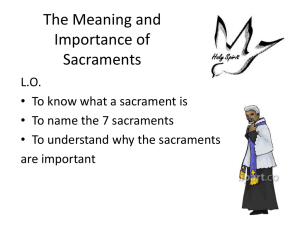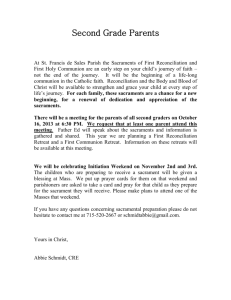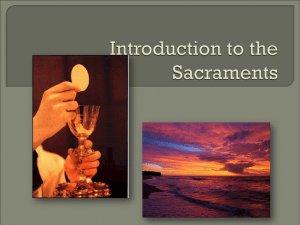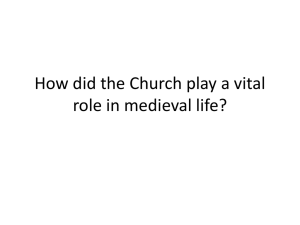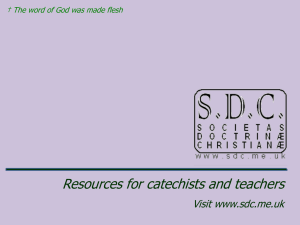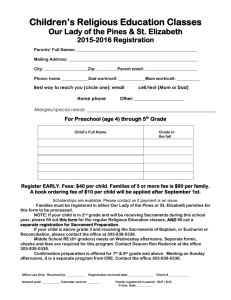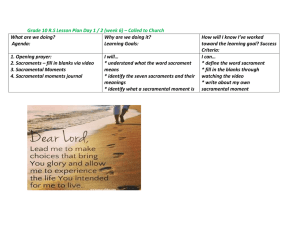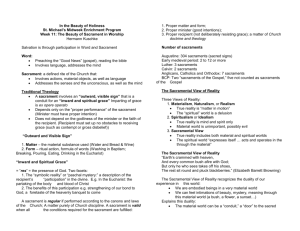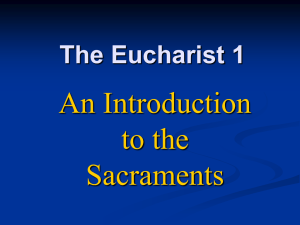File - LIGHTing the Way
advertisement
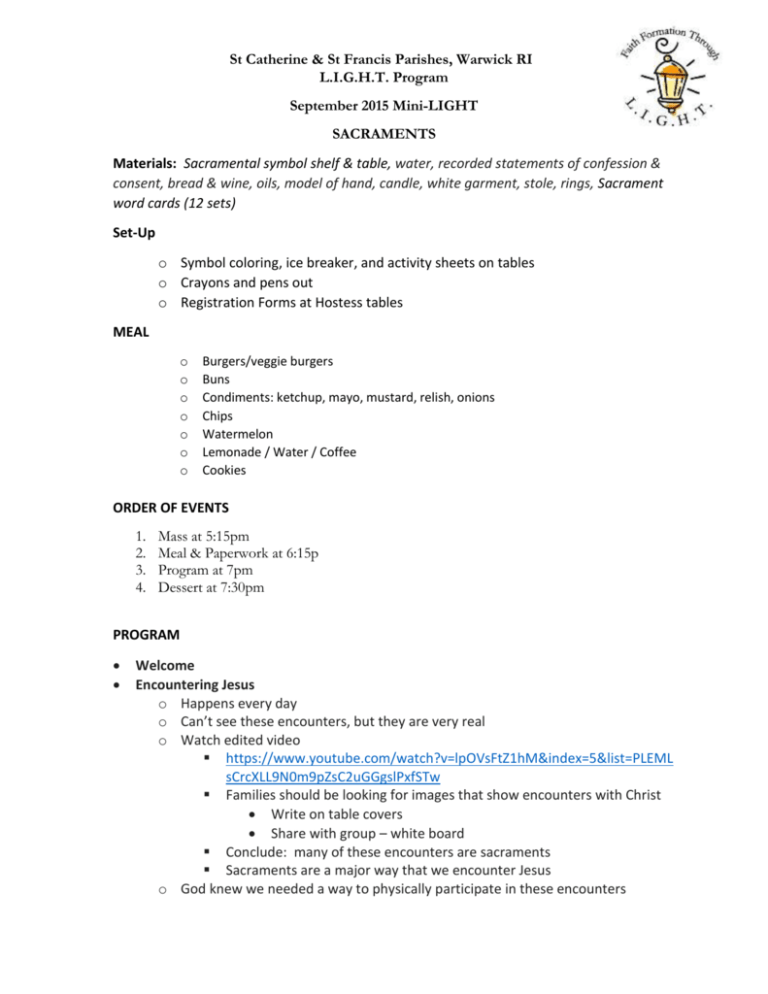
St Catherine & St Francis Parishes, Warwick RI L.I.G.H.T. Program September 2015 Mini-LIGHT SACRAMENTS Materials: Sacramental symbol shelf & table, water, recorded statements of confession & consent, bread & wine, oils, model of hand, candle, white garment, stole, rings, Sacrament word cards (12 sets) Set-Up o Symbol coloring, ice breaker, and activity sheets on tables o Crayons and pens out o Registration Forms at Hostess tables MEAL o o o o o o o Burgers/veggie burgers Buns Condiments: ketchup, mayo, mustard, relish, onions Chips Watermelon Lemonade / Water / Coffee Cookies ORDER OF EVENTS 1. 2. 3. 4. Mass at 5:15pm Meal & Paperwork at 6:15p Program at 7pm Dessert at 7:30pm PROGRAM Welcome Encountering Jesus o Happens every day o Can’t see these encounters, but they are very real o Watch edited video https://www.youtube.com/watch?v=lpOVsFtZ1hM&index=5&list=PLEML sCrcXLL9N0m9pZsC2uGGgslPxfSTw Families should be looking for images that show encounters with Christ Write on table covers Share with group – white board Conclude: many of these encounters are sacraments Sacraments are a major way that we encounter Jesus o God knew we needed a way to physically participate in these encounters o Jesus left us the sacraments as a means to do that Signs & Symbols o To help us understand what a sacrament is, let’s explore what a symbol is o “A visible signs that point to something more” o Give us the essence of what is going on when we see them Show signs: stop sign, restroom, danger Ask for reaction: what do they know/understand when they see o How about signs that we don’t necessarily see with our eyes Describe sensation: baking cookies, alarm clock, hot doorknob Ask for reaction: what do they know/understand when they experience o Signs and symbols are important because that are something with which our senses can relate to and understand, Sacraments o We use symbols in these rituals to help us understand what is going on Because we are physical beings with bodies, we need visible, tangible things to help us grasp the gift of God’s grace, to remind us that God is truly present to us Concrete things help us know Jesus is still with us. In the Sacraments, we can taste, touch, see, hear, and smell things that make tangible the presence of Jesus. o Sacraments are signs that point to something more: God’s love for us / His Grace o Encounters with Jesus, signs that relate to us His love for us o Jesus uses down-to-earth, concrete, and familiar things—like bread and wine, water, oil, and touch—to bring to us the reality of his presence. Introduce symbols of sacraments o Pull them from a box, explain them, and then place them into the display o o Main Symbols – physical sign which necessary for the sacrament to be valid, affects the sacrament (put these on shelves) Water – cleanses, vital for life, symbolized dying to sinful nature and emerging into new life in Christ Oil – strengthens & seals, from ancient times, anointing with oil meant setting the person apart for a particular mission. Touch – the ‘laying on of hands’. From ancient times, to impose hands on someone or to extend one’s hand over the person’s head was the sign of calling down the Holy Spirit. All seven sacraments employ this symbol in some way. Bread & Wine – the food of Himself that Jesus left us, Wheat is grown and ground, transformed by human work to make bread. Grapes are grown and crushed, transformed by human work to make wine. It is traditionally the work of human hands. Words – expression of sin and sorrow in Reconciliation and wedding vows in Marriage ceremony (record the beginning of the Act of Contrition and “I do”) Sacramentals – lesser signs that typically are part of the ritual, but not vital, do not affect the sacrament (put these on a separate table) Rings - a widely recognized sign of a marriage commitment in many cultures, they can be blessed as part of ceremony where they can help to symbolize the couple’s lifelong commitment to love and fidelity Stole - a “sign” of office. Wearing it indicates the positions of service to the community provided by bishops, priests and deacons Candle – symbol that the newly baptized receives the light of Christ White garment – symbolizes the cleansing power of Baptism, “putting on Christ” ACTIVITY: 1. Hand out 7 Cards to each table that name each sacrament 2. Symbol/sacramental will be held up 3. Table will decide which sacrament(s) it belongs to and hold up that card 4. Table that gets the most matches wins (gets to go to dessert table first) Water Confession & Sorrow (Act of Contrition) Bread & Wine Oil Laying on of Hands Mutual Consent (I do) Candle White Garment Stole Rings Baptism Reconciliation Eucharist Confirmation, Anointing, (Baptism, Holy Orders) Confirmation, Holy Orders, Anointing (all) Marriage Baptism Baptism Holy Orders Marriage Wrap Up: o The Seven Sacraments Video: https://www.youtube.com/watch?v=qmfSwi3ZKH4&index=4&list=PLEMLsCrcXLL9N0m9pZsC2uGGgslPxfSTw o In the Sacraments that Jesus gave us we experience God’s love, friendship, healing, forgiveness, blessing, anointing, and saving grace these very tangible signs and symbols of the Sacraments make it possible for us to better understand and experience the wonder of God This year we’ll be using the symbols to help understand how we encounter Jesus Christ through the seven sacraments.
